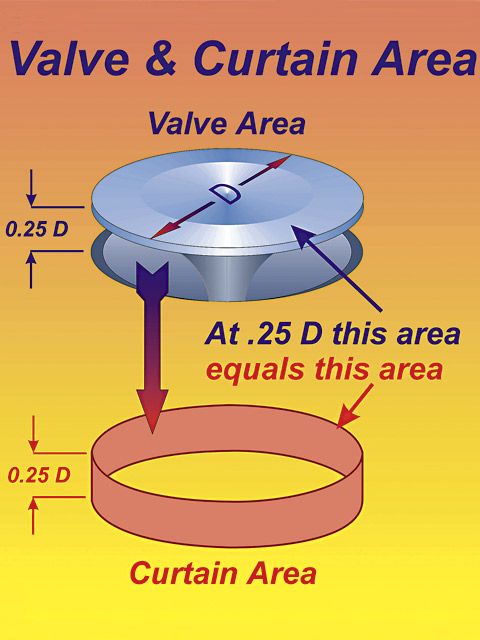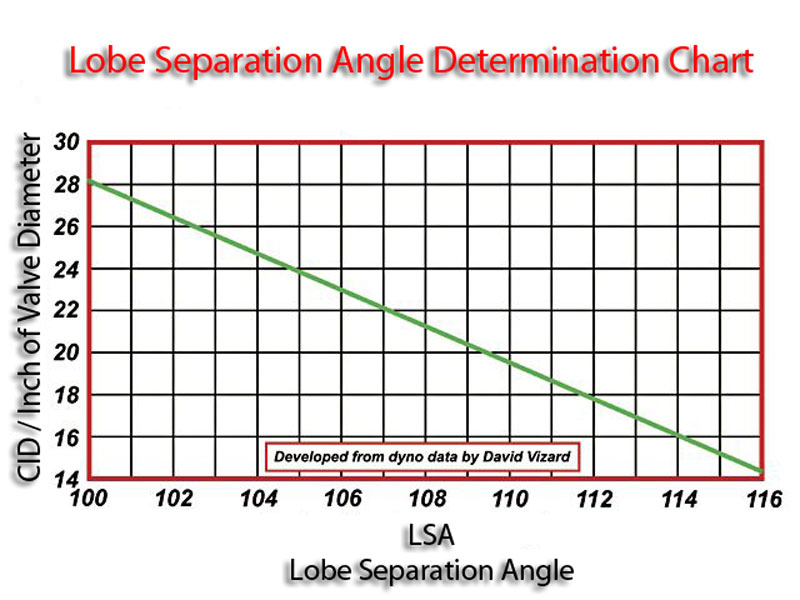my big quesions are these,
whats the difference between running a wild cam and a not as wild cam with longer rockers, if the dynamic compression with both are nearly the same?
what are the pros and cons of running high compression with a lower dcr through the cam or running normal compression with an equal dcr? (on 93 octane)
and does anyone have a quick list of cam company ph #s? i used to have one. ill call them all for recommended cam specs
referance for stock cams
http://www.nastyz28.com/sbchevy/sbccams.php
http://www.chevy-camaro.com/parts/chevy ... es-cam.htm
the cams durration effects both the dynamic compression and the effective rpm band that the cylinders fill efficiently in, while its true a low compression and a mild cam could easily have the same dynamic compression ratio as a high compression and much longer durration cam, combo the effective rpm band would be much differant and the low and high rpm performance would be vastly differant
http://garage.grumpysperformance.co...ectly-and-get-it-to-last-cam-install-info.90/
http://garage.grumpysperformance.com/index.php?threads/calculating-overlap-and-lsa-or-lca-etc.480/
http://garage.grumpysperformance.com/index.php?threads/cam-gear-and-timing-marks-etc.724/#post-1021
First Id point out that nearly everyone occasionally confuses or at least makes the mistake of using the wrong abbreviation, (LSA, and LCA) these are terms,that are almost, at least in many discussions interchangeable. which they are not.
LSA =LOBE SEPARATION ANGLE ........LSA is ground into the cam during manufactured, and can,t change,
http://garage.grumpysperformance.co...lsa-effects-your-compression-torque-dcr.1070/
LOBE SEPARATION ANGLE
Above 114 Deg. = Extremely Wide
114-112 Deg. = Wide
112-110 Deg. = Moderately Wide
110-108 Deg. = Moderate
108-106 Deg. = Moderately Tight
106-104 Deg. = Tight
Below 104 Deg. = Extremely Tight
VARYING LOBE SEPARATION ANGLE
Tighten.................................................Widen
Moves Torque to Lower RPM.................Raise Torque to Higher RPM
Increases Maximum Torque..................Reduces Maximum Torque
Narrow Power Band..............................Broadens Power Band
Builds Higher Cylinder Pressure............Reduce Maximum Cylinder Pressure
Increase Chance of Engine Knock.........Decrease Chance of Engine Knock.
Increase Cranking Compression...........Decrease Cranking Compression
Increase Effective Compression............Decrease Effective Compression
Idle Vacuum is Reduced........................Idle Vacuum is Increased
Idle Quality Suffers...............................Idle Quality Improves
Open Valve-Overlap Increases.............Open Valve-Overlap Decreases
Closed Valve-Overlap Increases...........Closed Valve-Overlap Decreases
Natural EGR Effect Increases................Natural EGR Effect is Reduced
Decreases Piston-to-Valve Clearance...Increases Piston-to-Valve Clearance
[color:red]LCA =(LOBE CENTER ANGLES)remember lobe center angles can be changed thru indexing the cam when degreeing it in[/color]
ADVANCING / RETARDING CAM TIMING
KEEP IN MIND MANY CAMS ARE FACTORY SET UP TO BE 4 DEGREES ADVANCED if INSTALLED DOT-TO-DOT
ADVANCING.
Begins Intake Event Sooner........................
Open Intake Valve Sooner..........................
Builds More Low-End Torque.......................
Decrease Piston-Intake Valve Clearance....
Increase Piston-Exhaust Valve Clearance...
RETARDING
Delays Intake Event Closes Intake
Keeps Intake Valve Open Later
Builds More High-End Power
Increase Piston-Intake Valve Clearance
Decrease Piston-Exhaust Valve Clearance
keep in mind theres three basic factors that are interlinked in that each has some effect on how the other two will effect the engines power curve
duration controls the number of degrees of rotation the valve takes from the time it lifts off its seat until it re-seats, the is the TIME the valve will be open and effects the rpm range , the cam will most efficiently operate in.
LIFT, controls the distance the valve opens,and combined with the valve diameter limits the valve curtain, so combined with duration in controls potential flow.

LOBE SEPARATION ANGLE will effect how effectively the exhaust can scavenge the cylinders and low rpm reversion pulse strength to some degree thus idle quality, as the period of time while both valves are open at the same time, greatly increases cylinder scavenging.





this charts based on a 350-383 chevy or similar size engine, but its a good rought guide on most engines under 400cid displacement on matching the durration to the intended operational rpm band
IDEALLY you would sellect the horsepower goal, and the displacement,youll work with too reach that goal. then the cylinder heads, intake and exhaust are sellected that supply the necessary flow rates,in that rpm band, you pick the cam too match the intended rpm band,and flow rates and power range for the application, you then match the compression ratio, to the cam timing too maintain the correct dynamic compression ratio, and you sellect the matching drive train and gearing to keep the engine IN the matched rpm band the vast majority of the time.
naturally if your limited to a set displacement or compression ratio the other factors must be sellected with those limits in mind.
heres free cam sellection software to narrow your choices
http://www.compcams.com/Camquest/default.asp
btw once you use it to find that approximate lift ,durration and lsa, you can buy any companies cams with similar specs.
most guys use the terms almost interchangably WHICH THEY ARE NOT in all cases!
LCA =(LOBE CENTER ANGLES)remember lobe center angles can be changed thru indexing the cam when degreeing it in, LSA (LOBE SEPERATION ANGLE) is ground into the cam during its manufacturing process.
CROWER cams
http://www.crower.com/misc/contact.shtml
CRANE CAMS
http://www.cranecams.com/
ENGLE CAMS
http://www.englecams.com/index.php
Tel: (310) 450-0806
Fax: (310) 452-3753
ISKY CAMS
http://www.iskycams.com/
phone: 323.770.0930
fax: 310.515.5730
ERSON
http://pbmperformance.com/store.php?catId=327
Lunati
technical support is availible by phone Monday through Friday 7AM to 5PM CST @
662 892-1500
http://www.popularhotrodding.com/tech/0 ... index.html
whats the difference between running a wild cam and a not as wild cam with longer rockers, if the dynamic compression with both are nearly the same?
what are the pros and cons of running high compression with a lower dcr through the cam or running normal compression with an equal dcr? (on 93 octane)
and does anyone have a quick list of cam company ph #s? i used to have one. ill call them all for recommended cam specs
referance for stock cams
http://www.nastyz28.com/sbchevy/sbccams.php
http://www.chevy-camaro.com/parts/chevy ... es-cam.htm
the cams durration effects both the dynamic compression and the effective rpm band that the cylinders fill efficiently in, while its true a low compression and a mild cam could easily have the same dynamic compression ratio as a high compression and much longer durration cam, combo the effective rpm band would be much differant and the low and high rpm performance would be vastly differant
http://garage.grumpysperformance.co...ectly-and-get-it-to-last-cam-install-info.90/
http://garage.grumpysperformance.com/index.php?threads/calculating-overlap-and-lsa-or-lca-etc.480/
http://garage.grumpysperformance.com/index.php?threads/cam-gear-and-timing-marks-etc.724/#post-1021
First Id point out that nearly everyone occasionally confuses or at least makes the mistake of using the wrong abbreviation, (LSA, and LCA) these are terms,that are almost, at least in many discussions interchangeable. which they are not.
LSA =LOBE SEPARATION ANGLE ........LSA is ground into the cam during manufactured, and can,t change,
http://garage.grumpysperformance.co...lsa-effects-your-compression-torque-dcr.1070/
LOBE SEPARATION ANGLE
Above 114 Deg. = Extremely Wide
114-112 Deg. = Wide
112-110 Deg. = Moderately Wide
110-108 Deg. = Moderate
108-106 Deg. = Moderately Tight
106-104 Deg. = Tight
Below 104 Deg. = Extremely Tight
VARYING LOBE SEPARATION ANGLE
Tighten.................................................Widen
Moves Torque to Lower RPM.................Raise Torque to Higher RPM
Increases Maximum Torque..................Reduces Maximum Torque
Narrow Power Band..............................Broadens Power Band
Builds Higher Cylinder Pressure............Reduce Maximum Cylinder Pressure
Increase Chance of Engine Knock.........Decrease Chance of Engine Knock.
Increase Cranking Compression...........Decrease Cranking Compression
Increase Effective Compression............Decrease Effective Compression
Idle Vacuum is Reduced........................Idle Vacuum is Increased
Idle Quality Suffers...............................Idle Quality Improves
Open Valve-Overlap Increases.............Open Valve-Overlap Decreases
Closed Valve-Overlap Increases...........Closed Valve-Overlap Decreases
Natural EGR Effect Increases................Natural EGR Effect is Reduced
Decreases Piston-to-Valve Clearance...Increases Piston-to-Valve Clearance
[color:red]LCA =(LOBE CENTER ANGLES)remember lobe center angles can be changed thru indexing the cam when degreeing it in[/color]
ADVANCING / RETARDING CAM TIMING
KEEP IN MIND MANY CAMS ARE FACTORY SET UP TO BE 4 DEGREES ADVANCED if INSTALLED DOT-TO-DOT
ADVANCING.
Begins Intake Event Sooner........................
Open Intake Valve Sooner..........................
Builds More Low-End Torque.......................
Decrease Piston-Intake Valve Clearance....
Increase Piston-Exhaust Valve Clearance...
RETARDING
Delays Intake Event Closes Intake
Keeps Intake Valve Open Later
Builds More High-End Power
Increase Piston-Intake Valve Clearance
Decrease Piston-Exhaust Valve Clearance
keep in mind theres three basic factors that are interlinked in that each has some effect on how the other two will effect the engines power curve
duration controls the number of degrees of rotation the valve takes from the time it lifts off its seat until it re-seats, the is the TIME the valve will be open and effects the rpm range , the cam will most efficiently operate in.
LIFT, controls the distance the valve opens,and combined with the valve diameter limits the valve curtain, so combined with duration in controls potential flow.

LOBE SEPARATION ANGLE will effect how effectively the exhaust can scavenge the cylinders and low rpm reversion pulse strength to some degree thus idle quality, as the period of time while both valves are open at the same time, greatly increases cylinder scavenging.





this charts based on a 350-383 chevy or similar size engine, but its a good rought guide on most engines under 400cid displacement on matching the durration to the intended operational rpm band
IDEALLY you would sellect the horsepower goal, and the displacement,youll work with too reach that goal. then the cylinder heads, intake and exhaust are sellected that supply the necessary flow rates,in that rpm band, you pick the cam too match the intended rpm band,and flow rates and power range for the application, you then match the compression ratio, to the cam timing too maintain the correct dynamic compression ratio, and you sellect the matching drive train and gearing to keep the engine IN the matched rpm band the vast majority of the time.
naturally if your limited to a set displacement or compression ratio the other factors must be sellected with those limits in mind.
heres free cam sellection software to narrow your choices
http://www.compcams.com/Camquest/default.asp
btw once you use it to find that approximate lift ,durration and lsa, you can buy any companies cams with similar specs.
most guys use the terms almost interchangably WHICH THEY ARE NOT in all cases!
LCA =(LOBE CENTER ANGLES)remember lobe center angles can be changed thru indexing the cam when degreeing it in, LSA (LOBE SEPERATION ANGLE) is ground into the cam during its manufacturing process.
CROWER cams
http://www.crower.com/misc/contact.shtml
CRANE CAMS
http://www.cranecams.com/
ENGLE CAMS
http://www.englecams.com/index.php
Tel: (310) 450-0806
Fax: (310) 452-3753
ISKY CAMS
http://www.iskycams.com/
phone: 323.770.0930
fax: 310.515.5730
ERSON
http://pbmperformance.com/store.php?catId=327
Lunati
technical support is availible by phone Monday through Friday 7AM to 5PM CST @
662 892-1500
http://www.popularhotrodding.com/tech/0 ... index.html
Last edited by a moderator:

